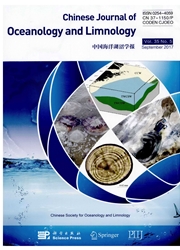

 中文摘要:
中文摘要:
着重加强长江河口区沉积物中重金属污染物的监测与效应评价研究,对于认识区域生态风险源具有指示意义。以三角褐指藻(Phaeodactylum tricornutum Bohlin)为试验材料,对长江口南支沉积物的浸出液毒性进行生物检测,研究浸出液中污染物对藻类生长和藻细胞内酯酶活性的毒性效应。结果表明,长江口南支部分站位沉积物浸出液对三角褐指藻具有毒性,以3号站毒性最大,该站使1 h时藻类细胞的酯酶活性增加3.1倍,4 d内藻类平均生长速率减少70%。经逐步回归分析,三角褐指藻的生长与浸出液中Cu、Zn、Pb、Cd的含量显著相关(R=0.99,p〈0.05),酯酶活性与Cu、Pb、Cd含量显著相关(R=0.97,p〈0.05)。
 英文摘要:
英文摘要:
Microalgae Phaeodactylum tricornutum were used to assess the toxicity of elutriate of sediment collected from seven stations at South Branch of Yangtze River estuary.Algal growth and cell esterase activity were chosen as toxic endpoints.The bioassay data showed that the toxicity effects had occurred in some of the samples.Elutriate of sediment at station No.3 had the most significantly toxic effects whilst 3.1 times more of esterase activity were increased at one-hour time and 70%of average algal growth rate was decreased within 4 days.Stepwise regression between toxic endpoints and heavy metal contents showed that the algal growth had significant correlation to copper,zinc,lead and cadmium contents in elutriate(R = 0.99,p0.05),and esterase activity was significantly related to copper,lead and cadmium contents in elutriate(R = 0.97,p0.05).
 同期刊论文项目
同期刊论文项目
 同项目期刊论文
同项目期刊论文
 期刊信息
期刊信息
